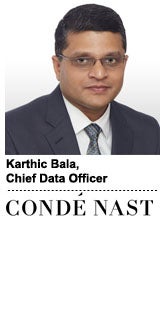Condé Nast has appointed the company’s first chief data officer as it doubles down on data and tech across its business groups.
Karthic Bala, most recently Condé’s head of data strategy, is also responsible for creating new data-driven revenue streams and expanding ad-supported products.
Its acquisition of data solutions company Lighthouse Datalab in late January spurred new growth for Condé’s 20-person-plus data science team. That unit is expected to double in size as the publisher staffs up around vertical specialties.
“All our customers are building marketing or data science teams and we wanted to create an environment where insights are shared in a more frequent way, in more real time,” Bala said. “We’re building this vertical specialization to enable brands and agencies to get to the right person and find the answers they need as fast as possible.”
New vertical specialties include pharma, health care, automotive and CPG, propelled by data partnerships with the likes of Nielsen Catalina.
Bala’s team is also responsible for growing Condé’s technology footprint, which already consists of Spire, its audience targeting and data management platform, and CitizenNet, its social advertising platform.
Bala spoke with AdExchanger about the evolving role of data within the Condé ecosystem.
AdExchanger: What will Condé Nast’s chief data officer do on a day-to-day basis?
KARTHIC BALA: This role is very focused on enabling all of the technology we’ve built for internal use and to provide access to tools like the Spire platform for all of our customers to use directly. We want to figure out how we can improve performance for clients in a much more efficient way in the current environment where people are consolidating their partnerships and creating more unique partnerships.
How will tech play a role here?
We want to be a much deeper partner for all of our clients, and that’s where Lighthouse Datalab and CitizenNet play together. Customers want to spend their money in the most efficient way across multiple channels, and they want a publisher to say, “This is the best way to execute your marketing,” and include content and insights about what consumers are consuming in an easy and frictionless way. We will build more data-driven revenue streams, and the tools we’ve created to service internal platforms will be accessible to customers for broader use.
One of the key things we’ve experienced as a brand and publisher is we have a lot of people who are buying our magazines or engaging with our platforms, which they may sign up for using their email addresses.
What does that allow you to do?
Fundamentally, we can do much more one-to-one marketing that’s identity-driven, and we are building the technology and platform to allow that to happen at scale. Over the next few years, we’re looking to figure out how to keep customers engaged in a very unique environment driven by content and brand, as opposed to just platforms and technology. It’s a combination of both.
We are trying to build an extremely data-driven culture within Condé Nast where everyone has access to data insights.
We see a drive by pubs to diversify their revenue streams, whether that’s through ads, commerce or subscriptions. Who do you interface with most within Condé to identify those new revenue opportunities?
Content creators want to understand what’s resonating in the world and with readers using trending social data, so content teams interact with my team. We also have a branded content studio, 23 Stories, and they want content-level insights to figure out what’s resonating with an audience so they can build the right creative across multiple platforms.
Ad sales and programmatic are a critical part of our business and education is a critical component of our strategy [across departments] so that, for instance, marketing is in lockstep with our sales teams. We have a lot of data-driven dashboards and UIs that enable our businesses to search and find answers to [business questions.]
We might want to understand revenue by brand or category, for instance, so we’re building an infrastructure to allow that to happen in real time.
What is Condé Nast’s approach to unifying audience and contextual data?
About two years back before we launched Spire fully, we made an effort to bring all of our data sets together within one single data lake, which enables us to look at audiences through the lens of what content they’re consuming and also using AI and predictive modeling to determine what content they might want to consume next.
One of the key things I’ve learned about Condé Nast is the fact that we’re a content-driven company, whereas other companies are platform-driven. They have lots of content, but the question of whether it’s real or not real is the big topic right now.
All of our content is created by reputable content creators, and we know a lot about the person who created that content. Our metadata is unique and special and we’re looking to use that information in the most effective way.
Interview condensed and edited.
















